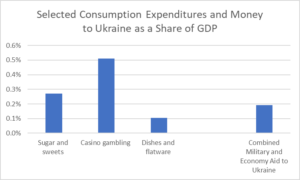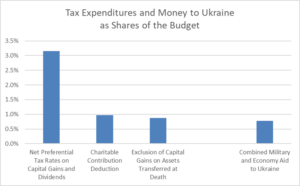October 02, 2023
The United States’ support of Ukraine, following the invasion by Russia, has featured prominently in the news in recent days as Republicans in Congress have made it front and center in the budget debate. As usual, the media has reported U.S. spending on military and economic assistance without providing any context for the spending. This likely leads both supporters and opponents of the aid to exaggerate its importance to the economy and its significance in the budget.
This is unfortunate, since it really is not possible to make an intelligent judgement of the importance of this aid without a real understanding of its size. To be clear, someone who considers the aid to be very important as a national security matter or as a humanitarian issue may be willing to give the aid even if it were an order of magnitude larger.
On the other side, people who consider the aid to be wasteful, or even counter-productive, may oppose it even if the sums involved were one-tenth as large. But to have a serious debate people should have a clear idea of the sums involved and just tossing around billions or tens of billions of dollars is utterly meaningless to the overwhelming majority of people who are not budget wonks.
People familiar with my blog will know that this is not a new concern for me. I have literally been haranguing reporters for decades about their refusal to provide any context for numbers that they know are meaningless to almost their entire audience. For some reason, they refuse to provide any sort of context even when it would likely just take a minute or two to provide a comparison that could make the number meaningful.
I thought I had finally broken through on this point back in 2013, when Margaret Sullivan, then the New York Times Public Editor, wrote a column where she completely accepted this point. She also managed to get strong agreement from David Leonhardt, who was the paper’s Washington editor at the time.
While I had hoped for a change in practice at the NYT, which would then lead other news outlets to follow, nothing changed. We still routinely see large numbers reported, without any context that would make them meaningful to readers.
Anyhow, I will do the simple arithmetic on the money going to Ukraine. I realize that this discussion may seem to minimize the importance of the U.S. money going to Ukraine.
I am not trying to advance any political agenda here. I have serious concerns about U.S. policy in Ukraine, so I have no interest in trying to downplay the economic importance of the U.S. involvement. But we should be able to have a debate on the merits of the policy without misleading people on its economic impact. I hope that I can advance that, as well as calling attention to the importance of putting big numbers in context more generally.
Ukraine Spending as a Share of GDP
According to estimates from the Kiel Institute for the World Economy, the United States has spent just under $75 billion on aid to Ukraine (both economic and military) since the start of the war. If we say this has taken place over roughly one and half years, this figure comes to 0.19 percent of current U.S. GDP.
I have taken spending on some categories of consumption which are roughly comparable.[1] As is shown in the figure below, in the second quarter of 2023 spending on sugar and sweets came to 0.27 percent of GDP. Spending on casino gambling was more than twice as large at 0.51 percent of GDP. And spending on dishes and flatware was a bit more than half as much at 0.11 percent of GDP.

Source: Bureau of Economic Analysis and author’s calculations.
Ukraine Spending as Share of the Budget
Spending on Ukraine does come out of the federal budget, so we may think of it to some extent as being in competition with other spending or tax expenditures (tax breaks). Using fiscal year 2023 as the denominator, Ukraine spending came to 0.78 percent of spending.
By comparison, the preferential treatment (lower tax rate) on dividends and capital gains costs the government an amount equal to 3.15 percent of outlays.[2] The deduction for charitable contributions cost 0.97 percent of the budget. The exclusion of capital gains on assets transferred at death, cost the government 0.88 percent of total spending. (This means people who inherit assets like stock don’t have to pay taxes on unrealized capital gains on the stock.) This comparison is shown in the figure below.

Source: Congressional Budget Office and author’s calculations.
Spending on Ukraine is Not Bankrupting Us, but it May Still Not Be a Good Idea
These comparisons will hopefully allow people to better understand the costs associated with U.S. support for Ukraine. My guess is that they show it to be less important than most people believe. That doesn’t mean that the course pursued by the Biden administration is the best route, but people should be able to argue that position based on a clear understanding of the numbers.
[1] These data come from the Bureau of Economic Analysis, National Income and Product Accounts, Table 2.4.5U, Lines 94, 227, and 33, respectively.
[2] These calculations use data for 2019 (the most recent year available) from the Congressional Budget Office’s The Distribution of Major Tax Expenditures in 2019, Table 1. The denominator is outlays for 2019.







Comments